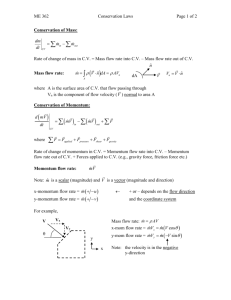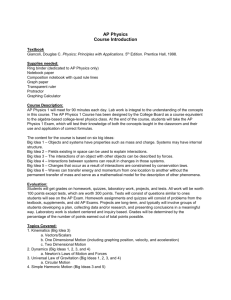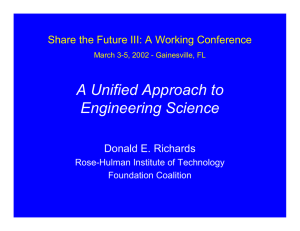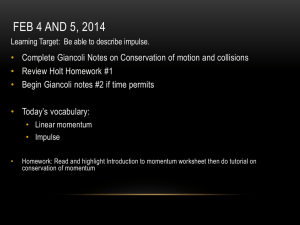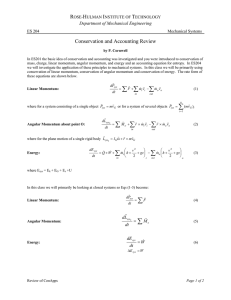A Unified Approach to Engineering Science Education Share the Future IV Conference
advertisement
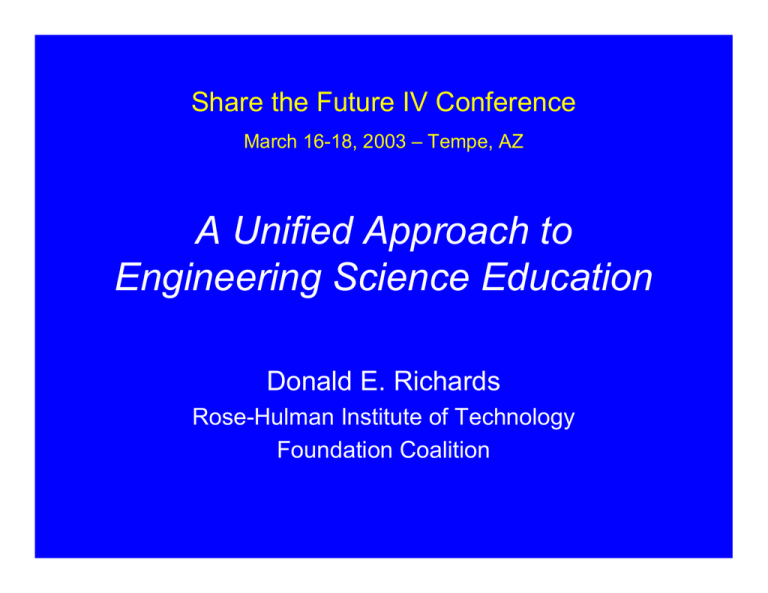
Share the Future IV Conference March 16-18, 2003 – Tempe, AZ A Unified Approach to Engineering Science Education Donald E. Richards Rose-Hulman Institute of Technology Foundation Coalition Foundation Coalition An NSF Engineering Coalition since 1993 “Creating an enduring foundation for student development and life-long learning” by rebuilding engineering curricula from the foundation up.” www.foundationcoalition.org 16-18 March 2003 Share the Future IV 2 Outline for Today • Engineering Science and the Motivation for Change • Framework for a Unified Approach • One Implementation -- the RoseHulman Sophomore Engineering Curriculum 16-18 March 2003 Share the Future IV 3 Group Activity 1 Answer the following questions: (a) Is there an engineering science and mathematics core curriculum that should be common for all engineering students? (b) Assuming that such a core is desirable, what courses or topics would you place in the core? 16-18 March 2003 Share the Future IV 4 Engineering Science & Engineering Education • Pre-1950’s • Grinter Report(1952-1955) “Report on the Committee on Evaluation of Engineering Education,” J. of Engr. Educ. 46 (Sept 1955) 1955, pp. 25-60 • Post Grinter Report • Today 16-18 March 2003 Share the Future IV 5 Recommendations of Grinter Report Courses Solids Statics X Mechanics of Materials X Dynamics X Fluids Thermo X X Thermodynamics X X Mass Transfer Electrical Materials ???? X Fluid Mechanics Heat Transfer Transfer Processes Today X X X X Circuit Theory X Materials X ????? 16-18 March 2003 Share the Future IV 6 Motivation for Change Improve -• student learning by responding to latest research on teaching and learning, and • curricular efficiency and effectiveness to meet demands for “new” material while maintaining or reducing credit hours. 16-18 March 2003 Share the Future IV 7 Research on Teaching & Learning • How People Learn: Brain, Mind, Experience, and School. (HPL) J. D. Bransford et al. editors, National Academy Press, Washington DC, 2001, expanded edition. Available online at http://www.nap.edu. • Teaching Introductory Physics. (TIP) A. B. Arons, John Wiley & Sons, New York, 1997. • Cooperative Group Problem Solving in Physics. (CGPiP) P. Heller and K. Heller, University of Minnesota, 1999. Available for download at http://www.physics.umn.edu/groups/physed. 16-18 March 2003 Share the Future IV 8 How People Learn - Bransford** • Nature of expertise – experts’ knowledge is hierarchically organized around major principles and concepts. – experts “construct” solutions from major principles. – experts monitor their activities to assess their success. • Current view of learning – individuals construct the knowledge they possess. – prior knowledge affects students’ ability to learn new knowledge. 16-18 March 2003 Share the Future IV 9 How People Learn - Bransford** • Learning and transfer – all learning involves transfer from previous learning. – amount and context of learning affects transfer. – abstract representations of knowledge combined with understanding can promote transfer. **Summarized in J. P. Mestre, “Implications of research on learning for the education of prospective science and physics teachers,” Physics Education, Vol. 36, No. 1 (Jan 2001), pp. 44-51. 16-18 March 2003 Share the Future IV 10 Implications of HPL • Help students organize their knowledge around important ideas and concepts. • Provide opportunities for students to “learn how to see” a problem like an expert. • Stress “Why and When?” as well as “What” and “How?” 16-18 March 2003 Share the Future IV 11 Implications of HPL • Help students integrate their new knowledge with existing knowledge. (constructivism) • Provide multiple contexts for learning and explicitly address transfer of knowledge. • Help students learn to monitor their learning and problem solving (metacognition). 16-18 March 2003 Share the Future IV 12 Lessons from TIP - Arons • Teaching for understanding not just memorization. – Importance of language and operational definitions. – Spiralling back - allow students to review or re-encounter important ideas and lines of reasoning in increasingly rich or sophisticated context. – Understand and address common misconceptions – Help students see their reasoning, both flawed and correct, and incorporate new knowledge into this structure. – Test and reward understanding not just memorization. • Promote Critical Thinking. Arons provides an excellent list of critical thinking processes. 16-18 March 2003 Share the Future IV 13 CGPiP - Heller & Heller • Modeling-coaching-fading paradigm • Modeling “culture of expert practice” – Conceptual framework or “story line” ties things together – Problem-solving methodology used explicitly by faculty and students. – Explicit decision-making by faculty solving problems. – Context-rich word problems that require construction of a solution not just “plug-and-chug” solution. – Grade solution strategy not just answer. • Coaching and Scaffolding – Cooperative group problem solving. 16-18 March 2003 Share the Future IV 14 Group Activity 2 • What, if any, are the common concepts or topics that run through an engineering science core? 16-18 March 2003 Share the Future IV 15 16-18 March 2003 Share the Future IV 16 + - + - 16-18 March 2003 Share the Future IV 17 Systems, Accounting, and Modeling Framework Framework The systems, accounting and modeling framework provides – A conceptual framework for engineering analysis. – A unified format for presenting and interpreting the basic laws that is uniquely suited for engineering applications. – A common,consistent problem-solving approach based on constructing problem-specific solutions from the underlying physical laws. 16-18 March 2003 Share the Future IV 19 Engineering Science Core* System Dynamics Heat Transfer Fluid Mechanics Materials Mechanics of Materials Thermodynamics Electrical Circuits Dynamics Differential Equations Statics Statistics Linear Algebra Chemistry Physics Calculus * One possible core 16-18 March 2003 Share the Future IV 20 Mass Electric Charge Linear Momentum Angular Momentum Mechanical Energy Energy Entropy Ohm’s Law Ideal Spring Dry Friction Ideal Gas Law Steam Tables Friction Factor Newtonian Fluid Viscous Drag What are the topics and concepts in the core? Node Free-Body Diagram Closed System Open System Control Mass Control Volume F=ma KCL Energy Equation Bernoulli’s Eqn Electric Current Torque Force Work Heat Transfer Mass Flow Equilibrium Steady state Rigid Boundary Pinned Joint Linear Translation Rigid Body Insulated Boundary Lumped Element Mass Electric Charge Linear Momentum Angular Momentum Mechanical Energy Energy Entropy Ohm’s Law Ideal Spring Dry Friction Ideal Gas Law Steam Tables Friction Factor Newtonian Fluid Viscous Drag What are the topics and concepts in the core? Node Free-Body Diagram Closed System Open System Control Mass Control Volume F=ma KCL Energy Equation Bernoulli’s Eqn Electric Current Torque Force Work Heat Transfer Mass Flow Equilibrium Steady state Rigid Boundary Pinned Joint Linear Translation Rigid Body Insulated Boundary Lumped Element Extensive Property Mass Electric Charge Linear Momentum Angular Momentum Mechanical Energy Energy Entropy Constitutive Relations Ohm’s Law Ideal Spring Dry Friction Ideal Gas Law Steam Tables Friction Factor Newtonian Fluid Viscous Drag What’s the method? System Node Free-Body Diagram Closed System Open System Control Mass Control Volume Interactions Electric Current Torque Force Work Heat Transfer Mass Flow Modeling Assumptions Equilibrium Steady state Rigid Boundary Accounting Principle Pinned Joint Linear Translation F=ma Rigid Body KCL Energy Equation Insulated Boundary Lumped Element Bernoulli’s Eqn Extensive Property Interactions System Constitutive Relations Modeling Assumptions Accounting Principle 16-18 March 2003 Share the Future IV 24 Accounting Equation for Extensive Property B dBsys dt = B in − B out + B gen − B cons Rate of Accumulation of B inside the system at time t 16-18 March 2003 Net Transport Rate of B into the system at time t. Share the Future IV Net Generation Rate of B inside the system at time t 25 Concepts & Definitions • Process • Model • System – Steady state – Finite time – Transient – Open system – Closed system • Interaction • Property – Intensive property – Extensive property • State of a system 16-18 March 2003 • Accounting Principle • Conserved Property • Constitutive Relation Share the Future IV 26 Group Activity 3 • Individually match the Word with its Definition. • When completed compare your answer with your team members. 16-18 March 2003 Share the Future IV 27 Accounting Equation for Extensive Property B d Bsys = dt B in - B out + B generated - B consumed net rate transported across the boundary into the system = Bnet,in = Bnet,in 16-18 March 2003 without mass flow without mass flow net rate generated within the system + B net,in with + Bgenerated - Bconsumed mass flow + ∑ mi bi - ∑ me be + B generated - B consumed in out Share the Future IV 28 Framework for Presenting and Interpreting Physical Laws • • • • • What’s the extensive property? How can it be counted? How can it be stored in the system? How can it be transported? How can it be generated or consumed? Rate of Storage = Net Transport Rate In + Net Generation Rate Fundamental Physical Laws Extensive Property Mass Charge Momentum Physical Law Conservation of Mass Conservation of Charge Conservation of Momentum Energy Conservation of Energy Entropy Entropy Production & Accounting 16-18 March 2003 Share the Future IV 30 Group Activity 4 • Match the extensive property 16-18 March 2003 Share the Future IV 31 An Example Conservation of Linear Momentum Conservation of Linear Momentum What is linear momentum? The linear momentum of a particle is the product of the particle mass m and its velocity V: P ≡ mV 16-18 March 2003 Share the Future IV 33 Conservation of Linear Momentum How can it be stored in and quantified for a system? Psys = ∫ Vρ dV Vsys Psys = ∑ Pj = ∑ m j V j 16-18 March 2003 Share the Future IV 34 Conservation of Linear Momentum How can it be transported across the system boundaries? – External Forces • Contact Forces • Body Forces – Mass Transport 16-18 March 2003 Share the Future IV Fexternal V m 35 Conservation of Linear Momentum How can linear momentum be generated or consumed within the system? Experience has shown that it is impossible to create or destroy linear momentum; hence, we say that linear momentum is conserved. Pgen = Pcons = 0 16-18 March 2003 Share the Future IV 36 Conservation of Linear Momentum dBsys dt = B in - B out + ∑ m i bi - ∑ m e be + B gen - B cons in out Non - flow boundary Flow boundary d Psys dt 0 = P in - P out + ∑ m i Vi - ∑ m e Ve + P gen - P cons in out Non - flow boundary Flow boundary ∑F external 16-18 March 2003 Share the Future IV 37 Conservation of Linear Momentum dPsys dt = ∑F Rate of accumulation of linear momentum inside the system at time t . 16-18 March 2003 ext = + ∑ mi Vi - ∑ me Ve out in Net transport rate Net transport rate of linear momentum of linear momentum into the system + into the system by external forces by mass flow at time t . at time t . Share the Future IV 38 Recovering F = ma dPsys = ∑ Fext + dt Closed System mi Vi - ∑ me Ve ∑ in out Psys = mG VG =0 m d d ( mG VG ) = mG ( VG ) = mG aG dt dt → Fnet = mG aG = F F ∑ ext net Rate Form of Basic Laws dmsys dt dqsys dt d Psys dt d L o,sys dt dE sys dt dSsys dt = ∑ m - ∑ m i in e out = ∑ q i - ∑ q e in = out ∑ m F + V m V ∑ ∑j ext, j in i i out e e i (ri × Vi ) - ∑ m e (re × Ve ) = ∑ Mo, j + ∑ m in j out = Q net,in + W net,in =∑ j Q j i + ∑ m in Vi 2 + gzi hi + 2 i si - ∑ m e se + S gen + ∑ m out T j in e - ∑m out Ve 2 + gze he + 2 Rate Form of Basic Laws dmsys dt dqsys dt d Psys dt d L o,sys dt dE sys dt dSsys dt ∑ m - ∑ m = i in e out = ∑ q i - ∑ q e in = out ∑ Fext, j + j = ∑ Mo, j + ∑ m i (ri × Vi ) - ∑ m e (re × Ve ) in out i + ∑ m in Vi 2 + gzi hi + 2 j = Q net,in + W net,in = ∑ j Q j Tj ∑ m i Vi - ∑ m e Ve in out + e - ∑m out Ve 2 + gze he + 2 ∑ m i si - ∑ m e se + in out S gen A common, consistent problem solving approach. Common Problem Solving Format • • • • Known Find Given Analysis – Strategy – Constructing model – Solution • Comments 16-18 March 2003 Typical Questions • What’s the system? • What properties should we count? • What’s the time interval? • What are the important interactions? • What are the important constitutive relations? • How do the basic equations simplify? • What are the unknowns? • How many equations do I need? Share the Future IV 43 A couple of examples Find Vx(t). Find h(t). x 1 F 2 h Extensive Property? Extensive Property? System? System? 1 m F 2 m 16-18 March 2003 Fspring Ffriction Share the Future IV 45 Mass Linear Momentum 1 m 2 m F x dmsys - m = m 1 2 dt d ρ A h = m - C gh tank 1 dt dh = m1 - C gh ρ Atank ρ Atank dt Fspring Ffriction dPx,sys = F - Ffriction - Fspring dt d mV = F - µ mg - kx k x dt dVx = F - µ g - kx m m k dt Advantages of this Approach • Provides a conceptual framework for the engineering science core. • Provides a unified format for presenting and understanding the basic laws that is uniquely suited for engineering applications. • Enables the use of a common, consistent problem solving approach. • Helps students (and faculty) see links between apparently unrelated topics by reinforcing the underlying similarities. 16-18 March 2003 Share the Future IV 47 How could you use this? • As the basis for modifying an existing course. • As the basis for a new course – ME 10 - Introduction to Engineering Analysis (Stanford) – BioE 252 - Conservation Principles in Biology & Medicine (Rice) • As the basis for a new curriculum – Sophomore Engineering Science Sequence (TAMU) – Sophomore Engineering Curriculum (RoseHulman) 16-18 March 2003 Share the Future IV 48 Where did this approach come from? • 1987 - Unified Engineering Science Curriculum Project – NSF-funded project at Texas A&M – Developed a four-course sequence of sophomore engineering courses (the “20X sequence”): • • • • Conservation Principles in Engineering Properties of Matter Modeling/Behavior of Engineering Systems Conservation Principles of Continuous Media – http://www-chen.tamu.edu/uesc/ 16-18 March 2003 Share the Future IV 49 Where did this approach come from? • L. Prandtl’s fluid mechanics work in the early 1900’s. – What Engineers Know and How They Know It Walter G. Vincenti, Johns Hopkins Press, 1990. • Discipline of System Dynamics • References from physics – H. Burkhardt, “System physics: A uniform approach to the branches of classical physics.” Am. J. Phys. 55, 344-350, 1987. – Chapter 1 in H. Fuchs, The Dynamics of Heat. Springer-Verlag, 1996. 16-18 March 2003 Share the Future IV 50 What Engineers Know and How They Know It Walter G. Vincenti, Johns Hopkins Press, 1990. • “Organization according to control-volume ideas is thus not only simpler but brings clearer understanding of the physical principles common to otherwise disparate situations.” • “Control-volume analysis is useful precisely because it provides a framework and method for thinking clearly about a large class of the often confusing problems that arise in engineering design.” From Chpt 4, “A Theoretical Tool for Design: Control-Volume Analysis, 1912-1953” 16-18 March 2003 Share the Future IV 51 Textbooks • C. J. Glover, K. M. Lunsford, J. A. Fleming, Conservation Principles and the Structure of Engineering, 5th ed, McGrawHill, New York, 1996. • D. E. Richards**, Basic Engineering Science - A Systems, Accounting and Modeling Approach, Rose-Hulman Institute of Technology, 2001. • W. C. Reynolds**, Introduction to Engineering Analysis, Stanford University, Spring 2000. • L. V. McIntire, A. Saterbak, and K-Y San, Conservation Principles in Biology and Medicine, underdevelopment for Prentice-Hall, Rice University. **Available from the authors. 16-18 March 2003 Share the Future IV 52 Rose-Hulman / Foundation-Coalition Sophomore Engineering Curricula What is the Rose-Hulman Sophomore Engineering Curriculum? • An eight-course sequence that integrates core material in engineering science and mathematics. – Designed for all engineering majors. – Developed by a multi-disciplinary team of faculty and students over two years. – Taught since 1995-1996. – Required for electrical, computer, and mechanical engineering students. 16-18 March 2003 Share the Future IV 54 What’s in our Core? Diff. Equations I Dynamics Fluid Mechanics Circuits Thermodynamics Diff. Equations II Statistics System Dynamics Matrix Algebra 32 Qtr. Credit Hours 16-18 March 2003 Share the Future IV 55 Sophomore Engineering Curriculum Fall Winter Spring Diff. Equations & Matrix Algebra I (4) Diff. Equations & Matrix Algebra II (4) Statistics for Engineers (4) Fluid & Thermal Systems (3) Conservation & Accounting Principles (4) Electrical Systems (3) Mechanical Systems (3) Analysis & Design of Engineering Systems (5) 30 Qtr. Credit Hours Sophomore Engineering Curriculum Advantages for Students • Participate in a coordinated curriculum that consciously stresses the links between engineering science and mathematics. • Provide a common foundation of engineering science and mathematics knowledge for future learning. • Learn to apply a common framework for problem solving based upon an understanding of the conservation and accounting principles. • Learn to handle open-ended problems. • Work with multi-discipline problems. • Learn cooperatively and work in teams. • Use computer technology across the curriculum. 16-18 March 2003 Share the Future IV 57 Sophomore Engineering Curriculum A Brief History Fall 1993 • Foundation Coalition funded by NSF. 1993-1994 • Institute considered various ideas for Sophomore Curriculum (Friday afternoon meetings) Summer 1994 • Workshops on teaming, active learning, curriculum design. (Approximately 4 days total) • Multidisciplinary faculty team developed overall framework for SEC. (12 faculty) 16-18 March 2003 Share the Future IV 58 Sophomore Engineering Curriculum A Brief History 1994-1995 • Met with departments and finalized proposal. • Proposal for pilot approved by Institute. • Required by electrical and computer engineering department. Summer 1995 • Team of 12 faculty and 3 students developed detailed curriculum material for eight courses. 16-18 March 2003 Share the Future IV 59 Sophomore Engineering Curriculum A Brief History 1995-1996 • Offered RH/FC SEC for first time to 90 students • Rose-Hulman required students to purchase a laptop computer. 1996-1997 • Adopted by mechanical engineering department for Fall 1998. 2002-2003 • Currently taken by 220-240 mechanical, electrical, and computer engineering students. 16-18 March 2003 Share the Future IV 60 Sophomore Engineering Curriculum Curriculum Structure FALL Quarter . . . . . . . . . . . . . . . . . . . . . . . . . . . . . . . 8 Credit Hours MA 221 - Differential Equations & Matrix Algebra I (4) ES 201 - Conservation & Accounting Principles (4) WINTER Quarter . . . . . . . . . . . . . . . . . . . . . . . . . . . 13 Credit Hours MA 222 - Differential Equations & Matrix Algebra II (4) ES 202 - Fluid & Thermal Systems (3) ES 203 - Electrical Systems (3) ES 204 - Mechanical Systems (3) SPRING Quarter. . . . . . . . . . . . . . . . . . . . . . .. . . . . . 9 Credit Hours MA 223 - Engineering Statistics (4) ES 205 - Analysis & Design of Engineering Systems (5) TOTAL CREDITS . . . . . . . . . . . . . . . . . . . . . . . . . . 30 Credit Hours 16-18 March 2003 Share the Future IV 61 Experience with SEC at RH • Reduced engineering credit hours from 20 to 18 without sacrificing material. • Faculty like – common problem solving approach that does not reinforce “plug and chug.” – emphasis on modeling assumptions and mathematics that apply across disciplines. – ability to restructure material and “spiral” back, e.g. dynamics in two courses. 16-18 March 2003 Share the Future IV 62 Experience with SEC at RH • Students comment favorably on “integration” and “big picture” view of curriculum. • Quantitative comparisons – SEC students did better than traditional students on final exam “workout” problems in dynamics, e.g. 20-40% more SEC students got problems right. 16-18 March 2003 Share the Future IV 63 Student Comments after Completing the SEC Student A “ES201 was an excellent foundation to start on. A solid handle on this class is a must for success in the following classes. All classes were connected to this class.” 16-18 March 2003 Share the Future IV 64 Student Comments Student B “The sophomore curriculum has won me over. At first, I thought it was a complete waste of time. Then during winter quarter I saw the importance of it. Now, I am glad to have gone through it. The book didn’t help much, it was vague and made the class more difficult.” 16-18 March 2003 Share the Future IV 65 Student Comments Student C “I was very pessimistic about the course (ES205) at the beginning of the quarter. This course defeated every pessimistic premise I had before it was completed. This course brought all the engineering disciplines together and, at the very least, made this skeptical EE a believer in the SEC. Not only was the course an eye-opener, but it also enhanced my ability to solve general complex-system problems regardless of what discipline they came from? 16-18 March 2003 Share the Future IV 66 Student Comments Student D “Perhaps one of my other gripes with the class is that it is so different from freshman physics. I actually prefer this method of teaching when it comes to frictions, tensions, angular momentum, etc. These are all topics with which I felt uncomfortable during freshman physics although I understand them better now. In the future, I would appreciate seeing the ConApps and Physics curriculums more closely integrated so that students only have to learn concepts once. 16-18 March 2003 Share the Future IV 67 Thank You! For additional information about the RH Sophomore Engineering Curricula or the Systems, Accounting, and Modeling Approach contact --Don Richards Rose-Hulman Institute of Technology 5500 Wabash Ave. - CM 160,Terre Haute, IN 47803 Email: donald.e.richards@rose-hulman.edu URL: www.rose-hulman.edu/~richards Phone: 812-877-8477 Or check the Foundation Coalition Web Site at http://www.foundationcoalition.org 16-18 March 2003 Share the Future IV 69

